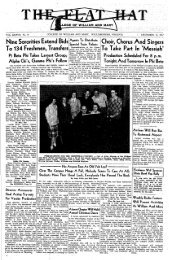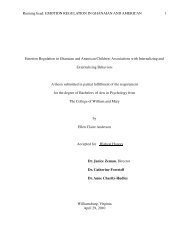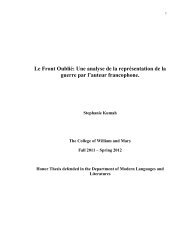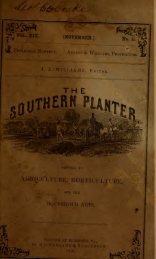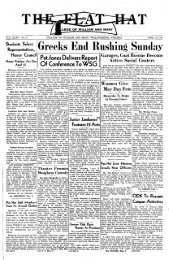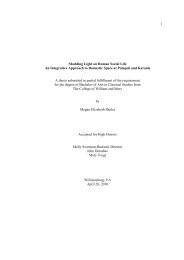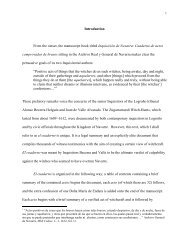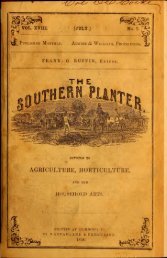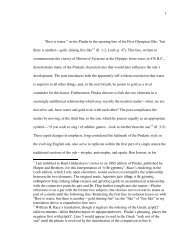Southern planter - The W&M Digital Archive
Southern planter - The W&M Digital Archive
Southern planter - The W&M Digital Archive
Create successful ePaper yourself
Turn your PDF publications into a flip-book with our unique Google optimized e-Paper software.
442 THE SOUTHERN PLANTER. [July<br />
nor too small." To ensure the mare being<br />
stinted she should be perfectly healthy, and<br />
living as much as possible in a state of na-<br />
ture ; not overfed with corn, but rather<br />
have cooling diet, unless she is poor. Fattened<br />
animals often prove barren. <strong>The</strong><br />
best time for covering is when the heat<br />
commences. If convenient it is often recommended<br />
to do so a second time when<br />
the heat passes off. " Like the broodmare,"<br />
says Stonehenge, "the stallion re-<br />
quires several essentials, commencing also,<br />
like her, 1st with his blood ; 2ndly, his in-<br />
dividual shape ; 3rdly, his health ; 4thly,<br />
his temper. But there is this difficulty in<br />
selecting the stallion, that he must not only<br />
be suitable, but he must also be adapted to<br />
the particular mare which he is to serve.<br />
Thus it will be manifest that the task is<br />
more difficult than the fixing upon a broodmare,<br />
because (leaving out of consideration<br />
all other points but blood) in the case a<br />
mare only has to be chosen, which is of<br />
good blood, for her particular work ; while<br />
in the other there must be the same atten-<br />
tion paid to this particular, and also to the<br />
stallion's suitability to the mare, or to<br />
" hit" with her blood. <strong>The</strong> rock upon<br />
which most men split is a bigoted favouritism<br />
for some particular horse ; thus one<br />
puts all his mares to Birkenhead, another<br />
to Hunting Horn, although they may every<br />
one be of different blood and form. Now<br />
this cannot possibly be righf, if there is<br />
any principle whatever in breeding; and<br />
however good a horse may be, he cannot be<br />
suited to all mares. Some say that any<br />
sound thorough-bred horse will do for a<br />
thorough-bred mare of the same kind, and<br />
that all is a lottery ; but I hope you now<br />
perceive that there is some science required<br />
to enable the breeder to draw many 'prizes.<br />
That the system generally followed of late<br />
is a bad one, I am satisfied, and with the<br />
usual and constant crossing and recrossing<br />
it is almost a lottery; but upon proper principles<br />
and careful management, there would<br />
be fewer blanks than at present. We cannot<br />
expect to find a perfect mare nor a per<br />
feet horse; there is some' "if this," or<br />
"but that" in all them. <strong>The</strong> breeder,<br />
however, must be particularly careful that<br />
both should not be faulty in the same place<br />
—that both should not have the same objection—and<br />
whereon one is deficient the<br />
other must be unusually developed. In<br />
thus matching his mares the judgment of<br />
the breeder is proved, that they may " hit"<br />
well. <strong>The</strong> same rule of course applies to<br />
all animals. Mr. Bell well observes, that<br />
" the importance of the influence of the<br />
sire in breeding horses is in no point more<br />
clearly proved than by the fact that the<br />
progeny of the most celebrated race-horses<br />
have generally sustained the reputation of<br />
their sires. Thus the descendants of<br />
Eclipse numbered no less than 364 winners,<br />
and those of Matchem, Highflyer, and<br />
other celebrated horses have partaken of<br />
the same inherited excellence. Sultan, the<br />
property of the Duke of Beaufort, which<br />
covered at £30 a mare after he was 20<br />
years old, Snap of the House, General, and<br />
Admiral of Ludlow, and not forgetting Sir<br />
Sampson, were celebrated stallions in this<br />
country 20 and 30 years ago ; and though<br />
they are long since dead, yet they now live,<br />
and are well known in their descendants.<br />
It is a remarkable fact that the first male<br />
put to a female, especially if he be potent,<br />
influences more or less the progeny of that<br />
female by subsequent males. A striking<br />
case of this kind was first published in the<br />
Philosophical Transactions. A splendid<br />
mare, seven-eighths Arab, had a mule by<br />
a quagga, in the year 1816, the mule bearing<br />
the unmistakable marks and stripes of<br />
the quagga. In the year 1817, 1818, and<br />
1823, this mare again foaled, and although<br />
she had not seen the quagga since 1816,<br />
her three foals were all marked with the<br />
curious quagga marks. Nor is this by any<br />
means an isolated case. Meckel observed<br />
similar results in the crossing of a wild<br />
boar with a domestic sow. Mr. Orton veri-<br />
fied this fact in the case of dogs, and poul-<br />
try. Mr. Merrick, in the Veterinarian, records<br />
the experience of his groom, who has<br />
had the management of stallions for 14<br />
years, " that he has frequently noticed that<br />
well-bred mares, which had been difficult to<br />
stint with thorough-bred horses, have bred<br />
to an inferior, and subsequently to a thorough-bred<br />
stallion ; but her stock by the<br />
latter has frequently showed traces of inferior<br />
blood, not to have been expected from<br />
the breed of either the sire or dam. You<br />
will, therefore, bear in mind that it is especially<br />
important that the first male given<br />
to a female should be well bred. I know<br />
that there is a foolish notion with some<br />
people about dogs, that the first litter is<br />
not likely to be good, therefore they allow<br />
the bitch for the first time to go about with



